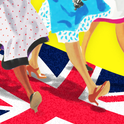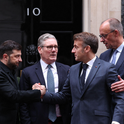A bottle of an Amazon worker’s urine, perched on top of a delivery box. A slim, greying paperback, auspiciously titled Leadership Secrets of Attila the Hun, bumping up against a thicker book: Jesus, CEO: Using Ancient Wisdom for Visionary Leadership. A framed campaign poster by American aircraft carrier Delta. “UNION DUES COST AROUND $700 A YEAR,” it cautions in thick block letters: “A new video game system with the latest hit sounds like fun. Put your money towards that instead.”
These items can be found in a new museum in Lewisham dedicated to exploring the history and effects of neoliberalism. The project first debuted, in slimmer form, at The World Transformed conference during the Labour party conference in Brighton in September. Now, it has found a permanent home in south London, in a small, eye-catching black building sandwiched between a local laundrette and beauty salon.
The term neoliberalism has gained traction in the past few years. Often serving as a catch-all descriptor for unbridled capitalism, some have taken to opine that the term then means, in fact, nothing. Those pronouncements—at least to me—have the tenor of someone who, upon seeing a fire quickly gathering ground, turns away to announce that since everything is being swallowed up, describing the scene with clarity is impossible. This confusion only seems to then naturalise the proverbial fire. For the Museum of Neoliberalism, its subject has a coherent meaning. Outside, a short description of the site introduces it as such: “Neoliberalism was an economic ideology that proposed ‘the market’ as an ethic in itself. Its proponents argued that the best outcome for everybody will be produced by business being given maximum freedom to control every aspect of life.” Its task, then, is specifically to explore the free-market ideology that started to gain ground in postwar economics departments to then shape the world.
If curious passers-by want an illustration of how this works in everyday life, they can shift their eyes rightward to the window display, where they will find a copy of “entrepreneurial” American tween magazine, Teen Boss (stylised as “Teen Bo$$!”), advising its young readers on “How to Build Your Brand, by being YOU!” Animated iPhones scroll to show articles demonstrating the marketisation of all inches of private life: A piece from Bloomberg, on the crisis of mental health, warns “Could your stress levels be affecting the economy?” Set in the very middle of the display is an advertisement from online marketplace Fiverr, which went viral this year for its unrelenting celebration of working oneself to the bone: “You eat a coffee for lunch. You follow through on your follow through. Sleep deprivation is your drug of choice. You might be a doer.”
The museum is small, but filled to the brim with detail. The first display, a detective’s “evidence board” of sorts set in a glass case, lays out a preliminary “Who’s Who” of neoliberalism. There are its seminal ideologues, Friedrich Hayek, Milton Friedman, and the 70s economists trained at the University of Chicago who famously advocated for limited government and deregulated markets. These theorists saw social life as a marketplace in and of itself, and people as economic agents trying to maximise their own satisfaction. There’s Ronald Reagan and Margaret Thatcher, who carried these ideas into government, where they still rattle about today. The display takes aim at those who have previously self-defined as being on the left to later embrace centrism: both Hillary Clinton and Tony Blair’s memoirs are stacked at the bottom of the display (an early crowdfunding campaign for the museum offered a Blair-themed Christmas card for those who pledged £2).
“Our vision is that the forces of the market are just that: They are forces; they are like the wind and the tides,” proclaims a quote from Arnold Harberger, a fellow Chicago School economist, printed across one wall. A museum, by its very nature, can denaturalise the naturalised; putting things on conspicuous, glass-cased display sets them up as exceptional, and perhaps even anachronistic. Neoliberalism vows to set the world towards a natural march to progress, abetted by market forces. To capture its objects and alienate them from their time also seems to make clearer another form of alienation: the gulf between our own lives and the larger historical narratives that circulate around us, but above our heads.
“This is a modest prototype that imagines what a future museum of neoliberalism might look like,” a wall text reads: “it offers an opportunity to look back on neoliberalism.” Walking through the installations, and seeing how market logic has pervaded every inch of human life—an Amazon-themed display that shows a body monitoring device put on company workers; a rolling list of service privatisation in the UK; a cross-section of Grenfell Tower’s combustible cladding—I didn’t quite feel transported into a hypothetical post-neoliberal future. Everything felt too close to home. But seeing these exhibits helped make the invisibility of market forces feel visible: denaturalised. These decisions—to put devices on employees; to lease public services out to the tides of the market; to opt for cheap building materials—were the result of economic theories that have become so omniscient as to be regarded as basic logic. Yet they were also decisions, ones made by people in meeting rooms.
When you finish the exhibit, you come into the museum’s small shop area. A deeply uninteresting—and easy—thing to say about this is to observe wryly, like a chin-stroking patrician, how interesting it is that an endeavour critical to capitalism nevertheless has its characteristics—which is an observation that still is made everywhere. “Look at those protestors on their iPhones” is a common criticism in this vein; there’s also the recent obsession with discrediting left-wing politicians on the basis of their clothing choices. But to say that is to elide one of the most important insights posed by the museum, which is that neoliberalism, and its style of unfettered free-market capitalism, is all-encompassing, the dominant logic by which we live. Besides, a free museum needs to pay its rent, thus needs money.
What the museum shows is how a set of ideas from a circle of 1970s economists have trickled down to shape all aspects of our lives, even our modes of self-understanding. We have, as Michel Foucault put it, become watchful entrepreneurs of ourselves. It’s the reason why we are obsessed with tracking our own productivity; why it’s common to feel guilt when relaxing; why so many discussions around the marginalised and vulnerable feel the need to differentiate between those who work hard and thus deserve our empathy and the ‘free-riders’ who don’t. What might it be like to live in a world where the dignity of humans is valued without qualification? Where there is no need to tie one’s right to life with a deference to one’s value (or one’s ‘talent’) in the market, and tweens don’t have to start worrying, at the tender age of eight, how they might need to “build your brand by being YOU!?”
The last display of the museum invokes the ghost of Thatcher to imagine a future that has surpassed her. “There is an alternative,” a wall text pronounces, alongside a screen that shows footage of the WTO Seattle protests in 1999. The museum’s own path out of this impasse is clear. By the door, coasters supporting the Labour Party are laid out, citing public spending commitments laid out in their recent manifesto. Neoliberalism, the museum concludes, is an “intellectually exhausted” project; the world might step into “something else. What that something else is is up to you.”
Halfway through the exhibition, I’m momentarily interrupted by another visitor. A middle-aged man, after browsing the window display outside, steps into the museum and looks around. “This is so cool!” he enthuses.
The Museum of Neoliberalism has been full every weekend since its opening mid-November, says co-curator Darren Cullen: “A lot of people have been saying that the museum articulates a kind of nameless frustration and rage they've had about the direction of politics these last 40 years and lays it all out.” Most visitors have made a dedicated trip to the museum, but some come in from the street. “It’s great to meet people who left the house not expecting to engage with politics come through the other side of the museum and animatedly want to talk about the issues it raises,” Cullen says.
To imagine a world without neoliberalism can seem impossible. What feels more achievable at this moment is coherence; to be able to give a name to a previously nameless frustration. Neoliberalism raises many problems: problems of human dignity, financial precarity, the winnowing of unencumbered leisure. It also presents a literary problem, one relating to narrative and agency (or the lack of it). The global financialisation of the economy has left many people without a language to make sense of their lives. As feminist scholar Silvia Federici said:
[su_quote]“Imagine living in a rural village in the Congo, or in Cameroon, where people don’t read English, and you have no idea why the prices of rice or of cotton and coffee are collapsing. You have no idea why yesterday there was a government board that you could bring your crop to, and today the government board that would have given you a guaranteed price is gone, and you cannot send your crop, and your crop is rotting. And you don’t know that in Chicago there was an agricultural meeting that set the prices. This mysteriousness causes a destructive unease. Not only from the suffering from the pain of the poverty, the cuts, but also from not understanding what is happening.”[/su_quote]
This sense of destructive unease ricochets everywhere in our world, to our detriment. Spaces like the Museum of Neoliberalism serve as a classroom and public forum to help people reflect on their own narratives, and how they run up against larger ones. Ironically, the museum’s own future in Lewisham seems also under threat: there are plans for the site to be demolished by property redevelopers. If it stands, the co-curators hope to expand the project.
When I leave, my fellow visitor begins a conversation with the museum staff about what he’s seen. It feels small, but important. Some things, after all, are not like the wind and the tides, no matter how naturalised they’ve become. “To name something is to presume to know it or to make it into something knowable,” essayist Rebecca Solnit wrote in Storming the Gates of Paradise. Maybe this will always involve some degree of fudging ideas, of imposing well-defined order on that which is diffuse, but then sometimes such clarity is desperately required. Some things can be reimagined, once they are named.
Find out more about the museum here
Inside the museum of neoliberalism
In displaying the objects of neoliberalism, the new south London museum allows us to imagine a better alternative
December 11, 2019

By defining neoliberalism, the museum invites its visitors to conceive of a better world. Photo: courtesy the museum











